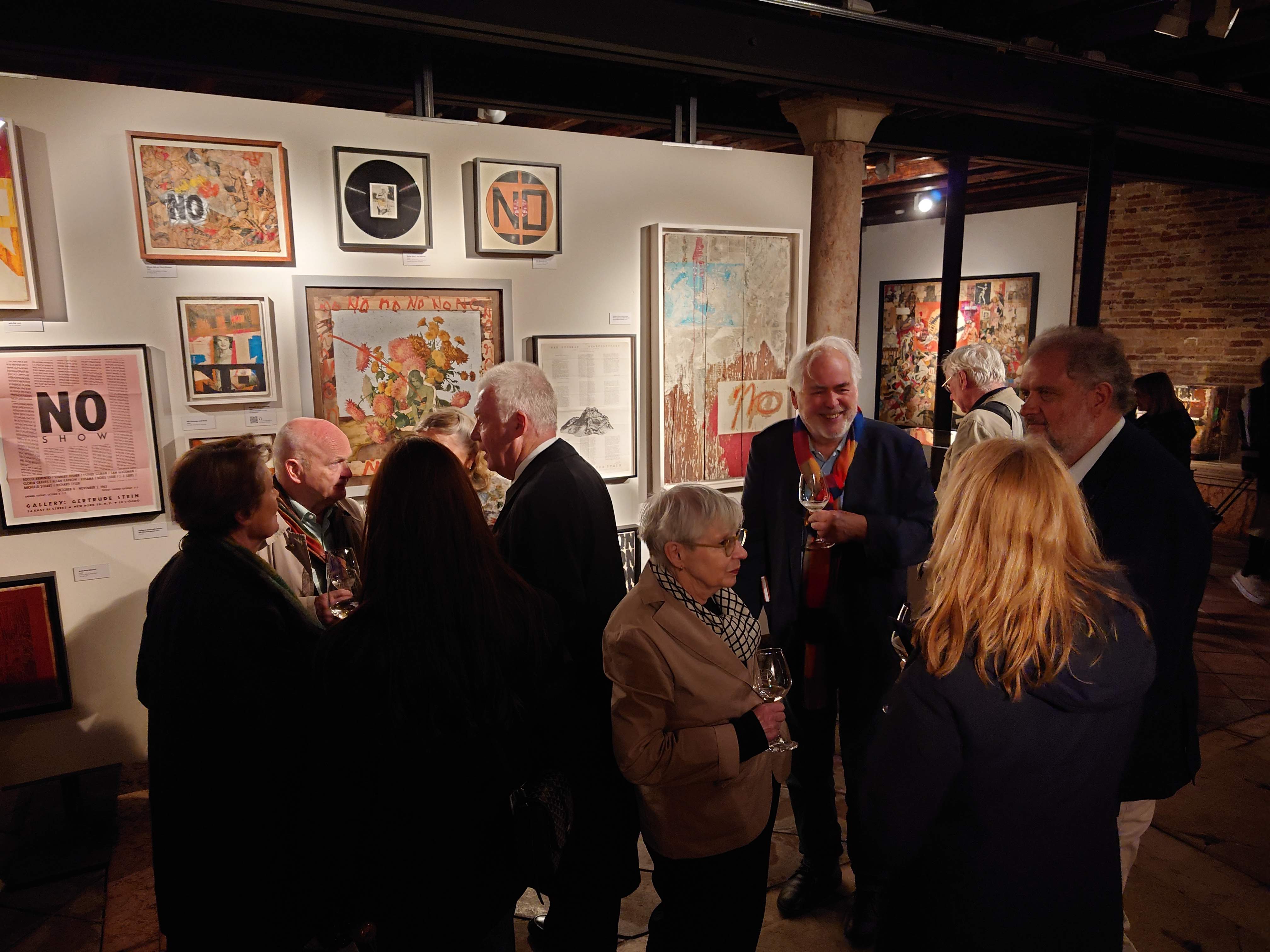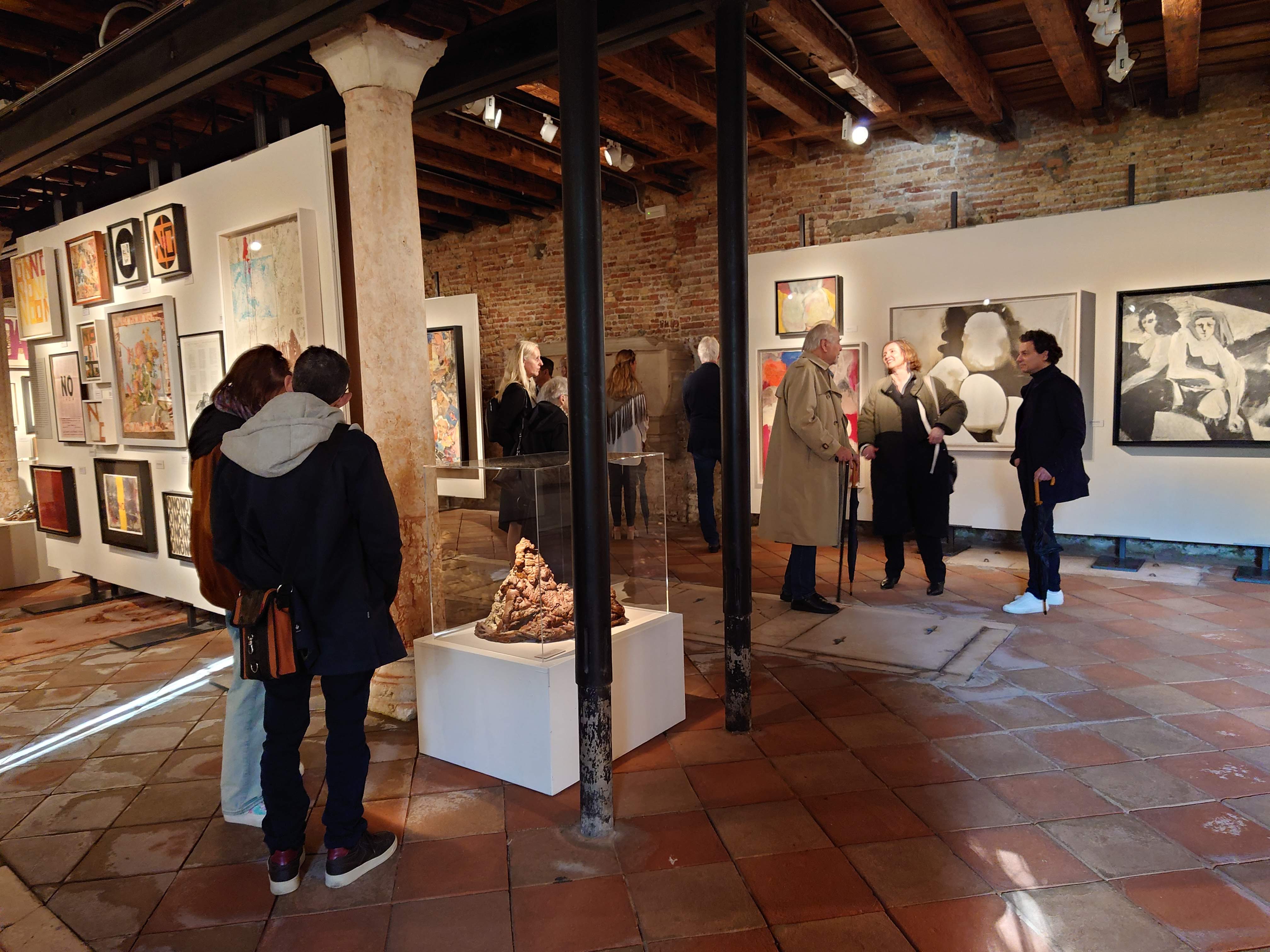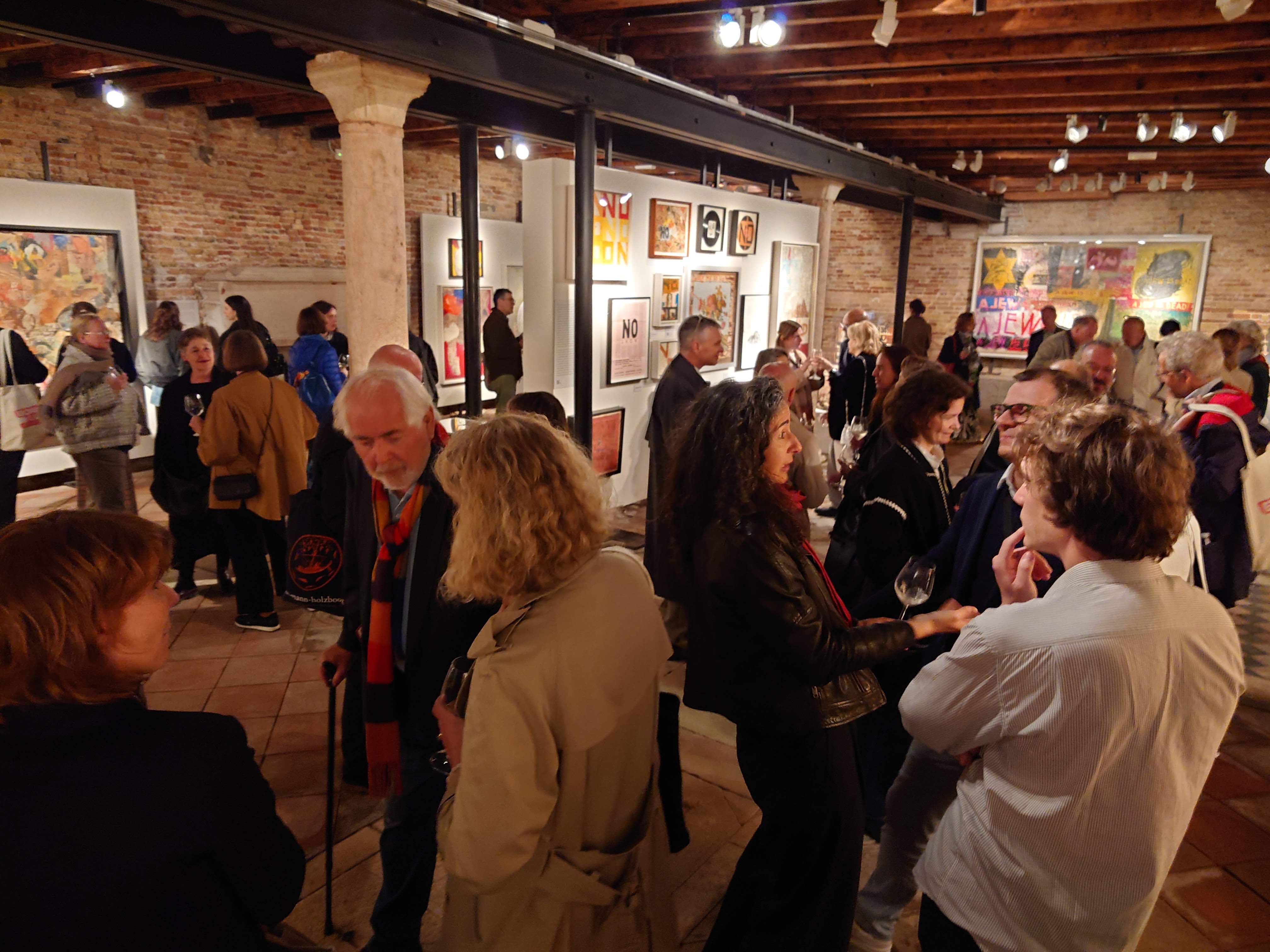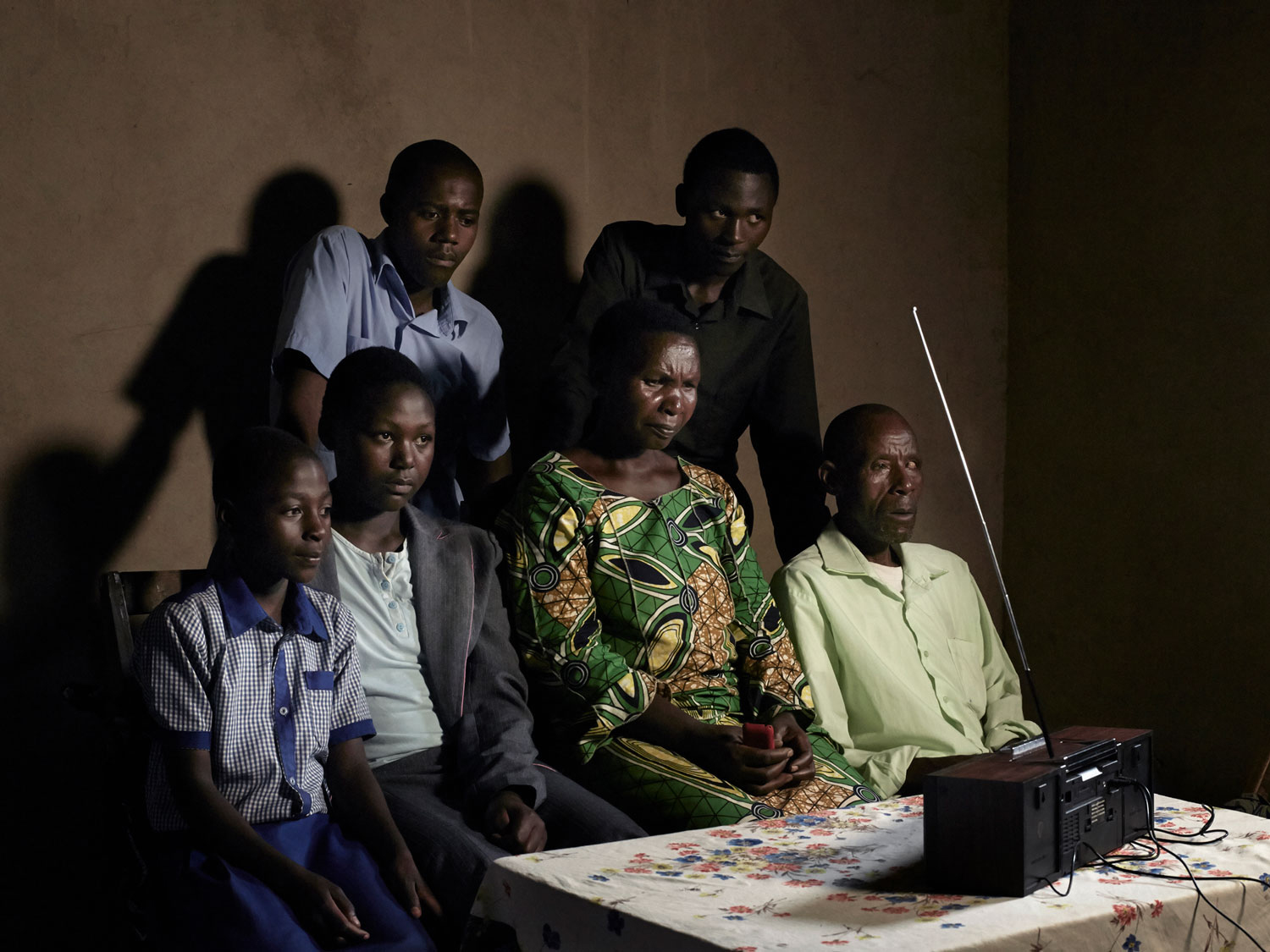"Life with the Dead" in Venedig eröffnet
18.4.2024

Am Mittwoch, den 17. April 2024, erlebte Venedig eine erfolgreiche und bewegende Ausstellungseröffnung anlässlich der 60. Kunst-Biennale: „Life with the Dead“ zeigt in den historischen Gebäuden der Scuola Grande San Giovanni Evangelista 55 Kunstwerke von Boris Lurie, der 2024 hundert Jahre alt geworden wäre. Ein besonderer Anlass, den die Boris Lurie Art Foundation NewYork und das Museum Zentrum für verfolgte Künste gerne nutzten, um das Werk des Künstlerseiner internationalen Öffentlichkeit zu präsentieren.
Die Eröffnungszeremonie begann mit einer faszinierenden Führung durch die Scuola Grande, die den Gästen einen Einblick in die historische Bedeutung des Veranstaltungsortes verschaffte. Tábaro Angelo von der Scuola Grande, Rafael Vostell, Vertreter der Boris Lurie Art Foundation für Europa und Dr. Jürgen Joseph Kaumkötter, Direktor des Zentrums für verfolgte Künste, begrüßten anschließend die rund 200 Gäste zur offiziellen Eröffnungsfeier in der Kirche San Giovanni Evangelista.
Nach einem Video-Grußwort von Ina Brandes, Ministerin für Kultur und Wissenschaft des Landes Nordrhein-Westfalen, sprachen Joi Grieg vom Vorstand der Boris Lurie Art Foundation und Prof. Dr. Jürgen Wilhelm, Vorsitzender der Kölnischen Gesellschaft für Christlich-Jüdische Zusammenarbeit. Alle betonten die Aktualität von Boris Luries künstlerischem Werk in Zeiten weltweit wachsenden Antisemitismus, Rassismus und Rechtspopulismus. Der Holocaust-Überlebende zeigt das Leid der Juden, das sein Leben für immer zeichnete, aber auch, wie eine Gesellschaft durch oberflächlichen Konsum, Verführung durch Pornografie und Machtperversion das Verbrechen gegen die Menschlichkeit zu vergessen droht.
Als Mitbegründer der NO!art-Bewegung schuf Boris Lurie vielfältige, provokante und teilweise extreme Collagen, Zeichnungen, Skulpturen und Texte. Seine Werke sind jedoch nicht nur Ausdruck des Leidens. Sie sind Symbole der Hoffnung eines der wenigen Überlebenden. Der Spazio Badoer neben der Kirche San Giovanni ist ein perfekter Ort für diese Ausstellung. Der Raum wurde einst als Grabstätte genutzt, und über der Tür stand das Wort Coemeterium (Bestattungsort). Es ist ein Ort der Ewigkeit und der Auferstehung.
Unter den Gästen der Eröffnungsfeier waren Delfina Jałowik vom Bunkier Sztuki Krakau, Maria Anna Potocka vom MOCAK Krakau und Staatsministerin a.D. Sylvia Löhrmann, Vorsitzende des Freundeskreises des Zentrums für verfolgte Künste. Die Liste der Anwesenden umfasste zudem bekannte Architekten, Persönlichkeiten der venezianischen Gesellschaft, Museumsdirektoren und Autoren wie René Block und Eckhart Gillen aus Berlin sowie Thomas Heyden und Simone Schimpf vom Neuen Museum Nürnberg.
Nach der offiziellen Eröffnung hatten die Pressevertreter:innen Gelegenheit, sich mit Kathrin Luz und Jürgen Kaumkötter zu treffen, um mehr über die Ausstellung zu erfahren und ihre Eindrücke festzuhalten.
Der Abend fand seinen Höhepunkt in einem exquisiten After-Show-Dinner im Restaurant Casa Cappellari, wo sich die Gäste in entspannter Atmosphäre austauschen und den Erfolg der Ausstellung feiern konnten. Mit einer eindrucksvollen Mischung aus Kunst, Kultur und Geselligkeit war die Eröffnung von Boris Luries Ausstellung ein lebendiges Ereignis voller bewegender Momente.
Die Ausstellung "Life with the Dead" ist bis zum 24. November 2024 Dienstag-Sonntag von 10-18 Uhr zu sehen. Im Verlag Hatje Cantz ist ein Katalog erschienen.
Fotos: Daniela Tobias/Zentrum für verfolgte Künste
What’s a Rich Text element?
The rich text element allows you to create and format headings, paragraphs, blockquotes, images, and video all in one place instead of having to add and format them individually. Just double-click and easily create content.
Static and dynamic content editing
A rich text element can be used with static or dynamic content. For static content, just drop it into any page and begin editing. For dynamic content, add a rich text field to any collection and then connect a rich text element to that field in the settings panel. Voila!
How to customize formatting for each rich text
Headings, paragraphs, blockquotes, figures, images, and figure captions can all be styled after a class is added to the rich text element using the "When inside of" nested selector system.
What’s a Rich Text element?
The rich text element allows you to create and format headings, paragraphs, blockquotes, images, and video all in one place instead of having to add and format them individually. Just double-click and easily create content.
Static and dynamic content editing
A rich text element can be used with static or dynamic content. For static content, just drop it into any page and begin editing. For dynamic content, add a rich text field to any collection and then connect a rich text element to that field in the settings panel. Voila!
How to customize formatting for each rich text
Headings, paragraphs, blockquotes, figures, images, and figure captions can all be styled after a class is added to the rich text element using the "When inside of" nested selector system.
What’s a Rich Text element?
The rich text element allows you to create and format headings, paragraphs, blockquotes, images, and video all in one place instead of having to add and format them individually. Just double-click and easily create content.
Static and dynamic content editing
A rich text element can be used with static or dynamic content. For static content, just drop it into any page and begin editing. For dynamic content, add a rich text field to any collection and then connect a rich text element to that field in the settings panel. Voila!
How to customize formatting for each rich text
Headings, paragraphs, blockquotes, figures, images, and figure captions can all be styled after a class is added to the rich text element using the "When inside of" nested selector system.
What’s a Rich Text element?
The rich text element allows you to create and format headings, paragraphs, blockquotes, images, and video all in one place instead of having to add and format them individually. Just double-click and easily create content.
Static and dynamic content editing
A rich text element can be used with static or dynamic content. For static content, just drop it into any page and begin editing. For dynamic content, add a rich text field to any collection and then connect a rich text element to that field in the settings panel. Voila!
How to customize formatting for each rich text
Headings, paragraphs, blockquotes, figures, images, and figure captions can all be styled after a class is added to the rich text element using the "When inside of" nested selector system.
What’s a Rich Text element?
The rich text element allows you to create and format headings, paragraphs, blockquotes, images, and video all in one place instead of having to add and format them individually. Just double-click and easily create content.
Static and dynamic content editing
A rich text element can be used with static or dynamic content. For static content, just drop it into any page and begin editing. For dynamic content, add a rich text field to any collection and then connect a rich text element to that field in the settings panel. Voila!
How to customize formatting for each rich text
Headings, paragraphs, blockquotes, figures, images, and figure captions can all be styled after a class is added to the rich text element using the "When inside of" nested selector system.
What’s a Rich Text element?
The rich text element allows you to create and format headings, paragraphs, blockquotes, images, and video all in one place instead of having to add and format them individually. Just double-click and easily create content.
Static and dynamic content editing
A rich text element can be used with static or dynamic content. For static content, just drop it into any page and begin editing. For dynamic content, add a rich text field to any collection and then connect a rich text element to that field in the settings panel. Voila!
How to customize formatting for each rich text
Headings, paragraphs, blockquotes, figures, images, and figure captions can all be styled after a class is added to the rich text element using the "When inside of" nested selector system.
What’s a Rich Text element?
The rich text element allows you to create and format headings, paragraphs, blockquotes, images, and video all in one place instead of having to add and format them individually. Just double-click and easily create content.
Static and dynamic content editing
A rich text element can be used with static or dynamic content. For static content, just drop it into any page and begin editing. For dynamic content, add a rich text field to any collection and then connect a rich text element to that field in the settings panel. Voila!
How to customize formatting for each rich text
Headings, paragraphs, blockquotes, figures, images, and figure captions can all be styled after a class is added to the rich text element using the "When inside of" nested selector system.
What’s a Rich Text element?
The rich text element allows you to create and format headings, paragraphs, blockquotes, images, and video all in one place instead of having to add and format them individually. Just double-click and easily create content.
Static and dynamic content editing
A rich text element can be used with static or dynamic content. For static content, just drop it into any page and begin editing. For dynamic content, add a rich text field to any collection and then connect a rich text element to that field in the settings panel. Voila!
How to customize formatting for each rich text
Headings, paragraphs, blockquotes, figures, images, and figure captions can all be styled after a class is added to the rich text element using the "When inside of" nested selector system.
What’s a Rich Text element?
The rich text element allows you to create and format headings, paragraphs, blockquotes, images, and video all in one place instead of having to add and format them individually. Just double-click and easily create content.
Static and dynamic content editing
A rich text element can be used with static or dynamic content. For static content, just drop it into any page and begin editing. For dynamic content, add a rich text field to any collection and then connect a rich text element to that field in the settings panel. Voila!
How to customize formatting for each rich text
Headings, paragraphs, blockquotes, figures, images, and figure captions can all be styled after a class is added to the rich text element using the "When inside of" nested selector system.
What’s a Rich Text element?
The rich text element allows you to create and format headings, paragraphs, blockquotes, images, and video all in one place instead of having to add and format them individually. Just double-click and easily create content.
Static and dynamic content editing
A rich text element can be used with static or dynamic content. For static content, just drop it into any page and begin editing. For dynamic content, add a rich text field to any collection and then connect a rich text element to that field in the settings panel. Voila!
How to customize formatting for each rich text
Headings, paragraphs, blockquotes, figures, images, and figure captions can all be styled after a class is added to the rich text element using the "When inside of" nested selector system.
What’s a Rich Text element?
The rich text element allows you to create and format headings, paragraphs, blockquotes, images, and video all in one place instead of having to add and format them individually. Just double-click and easily create content.
Static and dynamic content editing
A rich text element can be used with static or dynamic content. For static content, just drop it into any page and begin editing. For dynamic content, add a rich text field to any collection and then connect a rich text element to that field in the settings panel. Voila!
How to customize formatting for each rich text
Headings, paragraphs, blockquotes, figures, images, and figure captions can all be styled after a class is added to the rich text element using the "When inside of" nested selector system.
What’s a Rich Text element?
The rich text element allows you to create and format headings, paragraphs, blockquotes, images, and video all in one place instead of having to add and format them individually. Just double-click and easily create content.
Static and dynamic content editing
A rich text element can be used with static or dynamic content. For static content, just drop it into any page and begin editing. For dynamic content, add a rich text field to any collection and then connect a rich text element to that field in the settings panel. Voila!
How to customize formatting for each rich text
Headings, paragraphs, blockquotes, figures, images, and figure captions can all be styled after a class is added to the rich text element using the "When inside of" nested selector system.


















Materialien
Pressespiegel
Aktuelles
.jpg)
Wechselausstellung
:
Spuren in Stein – Jüdische Friedhöfe am Niederrhein
Ausstellung zum 100. Geburtstag des Fotografen Armin Alfermann
Das Museum Zentrum für verfolgte Künste zeigt vom 7. Mai bis 8. September 2024 die Fotoserie "Spuren in Stein" von Armin Alfermann über die jüdischen Friedhöfe am Niederrhein.


Führung
:
Öffentliche Sonntagsführung „Keine Freiheit ohne Pressefreiheit“
30 Jahre Reporter ohne Grenzen
Die öffentliche Führung im Zentrum für verfolgte Künste zeigt sechs Arbeiten aus den Jahresheften „Fotos für die Pressefreiheit“ der Organisation „Reporter ohne Grenzen“.


Führung
:
Führung zum Internationalen Museumstag mit Uli Preuss
Ausstellung „Keine Freiheit ohne Pressefreiheit. 30 Jahre Reporter ohne Grenzen“
Am Internationalen Museumstag, 19.5. um 13 Uhr, leitet Uli Preuss die öffentliche Führung durch die Ausstellung „Keine Freiheit ohne Pressefreiheit“ im Zentrum für verfolgte Künste.








